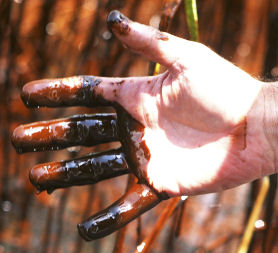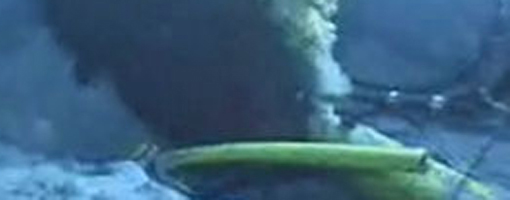BP oil disaster bigger than Exxon Valdez
Updated on 27 May 2010
President Obama has promised to clean up the oil industry in the wake of the Gulf of Mexico leak, while Professor Rick Steiner and Philippe Cousteau discuss for Channel 4 News the environmental "catastrophe".

London-based energy giant BP had estimated that about 5,000 barrels of oil have been leaking every day since the Deepwater Horizon rig collapsed, following an explosion that killed 11 people.
But the director of the US Geological Survey, Marcia McNutt, said today that the estimates of the flow from government teams range from 12,000 to 25,000 barrels per day, meaning that the spill has already eclipsed the previous worst US oil spill.
In March 1989, the tanker Exxon Valdez hit an undersea reef in Prince William Sound, Alaska, spilling a total of about 260,000 barrels of oil into the sea - the previous worst US oil spill.
"This is obviously a very, very significant environmental disaster and I think with the numbers I've given you, you can do the math," McNutt said.
President Obama said the clean up and containment operation was now "the largest effort of its kind in US history".
Documentary maker Philippe Cousteau described his experience of diving in a "toxic soup" below the surface in the Gulf of Mexico.
He told Jon Snow that we do not understand the consequences of the ecological disaster that is unfolding in the area.
He said there was a tremendous amount of volatile organic compounds and benzine and other chemicals in the oil that had leaked - "It's very toxic in and of itself." There was a fear that if it eventually sucked up all the oxygen in the water, larger and larger "dead zones" would be created.
"There is no good answer to this crisis," he maintained. "It is a catastrophe."
He concluded that in the long term we needed to move off our dependence on oil and to empower the next generation, through education, not to make the same mistakes that we have made.
Professor Rick Steiner, who studied the Exxon Valdez disaster, writes: "Despite what some oil company executives would have us believe, oil, water, fish, and wildlife actually don't mix.
More on the BP oil spill by Prof Rick Steiner
- BP to plug oil leak as biologist sounds warning
- Oil disaster: is battle already lost?
- BP Gulf spill environmental costs 'enormous'
- Deepwater: lessons to learn from the BP spill
"BP CEO Tony Hayward's statement that the environmental damage from the Deepwater Horizon disaster will be 'very, very modest' is simply one of the most arrogant, ignorant, callous statements I have ever heard from any corporate CEO during a crisis such as this.
"The environmental damage from the Gulf spill has already been, and will continue to be, enormous. Whenever thousands of tons of toxic hydrocarbons are spilled into a productive coastal and marine ecosystem, the damage will unavoidably be serious.
"And as this spill is so unique, with so much oil coming into the sea at 5,000 feet deep and 50 miles from shore, the impacts will be very different than in most other surface spills with which people are more familiar."
BP's latest attempt to seal the leak using a method known as "top kill" got under way yesterday. Earlier, the LA times reports that Thad Allen, who is coordinating the government response, said the effort has pumped in enough fluid to stop the leak of oil and gas.
Pressure in the well has reduced, the newspaper's website reported, and cement will be used to seal it when the pressure reaches zero.
But the oil spill response command "cannot confirm or deny" the reports of success. Spokesman David Nicholas responded to the reports saying: "The top kill operation continues, there are no operational updates."
Earlier, BP Managing Director Robert Dudley said the operation was "moving the way we want it to" but it was too early to say if it had succeeded.
Live video feed of the BP oil spill
BP is broadcasting a live video feed showing the leaking pipe along with a containment devise aimed at siphoning the oil to the surface where it is then stored in a drillship.
Click on the image to view the video stream
In a statement this afternoon, President Obama said that the US administration will do "whatever necessary" to preserve the Gulf coast, but that there was no guarantee the latest action would stop the leak. He added that BP will "pay every dime" of the cost of the disaster.
He suspended the exploration of two sites off Alaska, cancelled an August lease sale in the Western Gulf, extended a moratorium on permits to drill new deepwater wells for six months, and suspended action on 33 deepwater exploratory wells being drilled in the Gulf of Mexico.
He also said the "tragedy" underlined the need to develop clean and renewable sources of energy.
"(Obama) will announce standards to strengthen oversight of the industry and enhance safety, a first step in a process that the independent presidential commission will continue," an aide said earlier.
"While the commission performs its work to determine how to prevent this from ever happening again, the moratorium on permits to drill new deepwater wells will continue for a period of six months."
The aide added that Interior Secretary Ken Salazar also briefed the president about the content of a report on the rig explosion and the disastrous oil leak.
Professor Steiner writes: "The Obama administration, which campaigned on a platform of transition to sustainable energy, needs to suspend entirely its recently released plan for more oil drilling on the Outer Continental Shelf (OCS), and take full advantage of this wake up call to take us in a new direction."
'Saving money'
BP was also facing increasing criticism for its management of the oil rig before the disaster. The New York Times quoted a BP document it received from a congressional investigator which indicated that BP had tried to save money by taking a chance on the type of casing cement it used on the well. The newspaper said gases were leaking through the casing hours before the explosion.
BP CEO Tony Hayward says "a series of failures" led to the accident, but he has denied this had to do with cost saving.
Elizabeth Birnbaum, the director of the US Minerals Management Service which oversees drilling, has also resigned, US Interior Secretary Ken Salazar told a congressional subcommittee today.
Many US lawmakers and environmental groups blamed the lax regulation by MMS of offshore drilling rigs and production platforms for helping cause the oil spill.
Top Kill and Junk Shots - what it all means:
BP is pinning its hopes on stopping the flow of oil from its well in the Gulf of Mexico on a technique called Top Kill. Science Correspondent Julian Rush explains what it is.
There were some pretty snide comments made by US politicians when it emerged that BP planned to block the flow of oil from its ruptured well by firing golf balls, pieces of rope and bits of old rubber tyre into the pipe. But there was science behind the choice of objects.
Top Kill is a well established oil industry technique used to shut off broken wells. I watched it being used, for example, in the aftermath of the first Gulf War when Saddam Hussein's retreating Iraqi troops set fire to hundreds of oil wells in the Kuwaiti desert.
But it has never been tried before 5,000 feet under the ocean.
The idea is simple. Officially called "bridging material", the "junk shot" of golf balls and other objects is pumped down a pipe from the surface into a manifold that BP engineers are connecting to two valves - the Choke and Kill Valves - on the Blowout Preventer (BOP). That is the device on the seabed at the top of the well whose spectacular failure to automatically shut off the flow of oil when the Deep Water Horizon rig exploded in a fireball caused the spill.
Also in a chamber in the manifold is tonnes of heavy mud, called kill mud.
The manifold is like a loaded double-barrelled shotgun, the mud and the junk shot pumped to very high pressures.
First the junk shot is fired from one barrel into the BOP where it should lodge against the partially closed rams that should have closed fully to stop the flow originally. The golf balls and bits of rubber tyre are chosen carefully to be both flexible enough to catch and tangle inside the riser pipe in the BOP and small enough to effectively block it.
Immediately afterwards the second barrel is fired, sending the mud into the BOP up against the blockage made by the junk shot and down into the well underground. Once enough mud is pumped in the flow should stop, when the final step, of cementing the well to seal it completely can begin.
If it fails first time, BP says it can reload the manifold and try again several times. But if it doesn't work at all then the only hope is the relief wells they are drilling. That will mean another two months of oil gushing out before the well can be capped.
BP are also facing criticism from a different quarter - Twitter. A spoof Twitter feed on the oil disaster, @BPGlobalPR, has attracted over 55,000 so far for its tweets including:
- The LA Times is reporting that Top Kill is working to plug the leak! Looks like our job here is done. See ya later gulf! #5dayweekend!
- BP: Cross you fingers and pray for our riskiest operation yet. We sent Terry to get the lunch order.
- People are really out to get us. I haven't seen the public attack somebody this unfairly since poor Jay Leno had to move his timeslot.
In contrast, a tweet sent today from legitimate feed @BP_America, which has just short of 7,000 followers, says ""Top kill" operations continued over the night & are ongoing. There are no significant events to report at this time. #oilspill".





